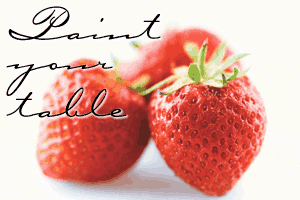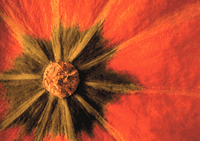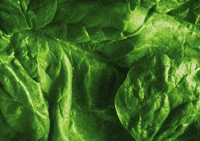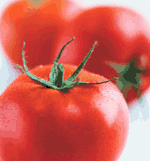Paint your table
by Karen McGeorge Sanders
This article was originally published in July 2002

Colorize your food choices. Paint your table with foods in all colors of the rainbow for good health.
See below:
Pigmented phytochemicals quick reference
Recent research and books such as “The Color Code” emphasize the health benefits of eating fruits and vegetables from the spectrum of produce colors. Nearly all fruits and vegetables are loaded with health-promoting properties attributed to natural plant compounds called phyto-chemicals. The benefits of eating many plant-based colors in your diet is considerable.
The National Cancer Institute recently launched a campaign called “Savor the Spectrum,” urging Americans to eat fruits and vegetables from each color group every day. Another book, “What Color Is Your Diet?” suggests doubling the government’s recommended “five a day” servings of fruits and vegetables to nine to 10 servings a day, based on the research that’s stacking up. The reason? Merely counting servings may not be adequate to get nutrients needed from one or more color categories.

Phytochemicals are naturally occurring compounds found only in plants. They’re produced for protection from sun damage, dehydration, insects, and disease. The word derives from the Greek word, phyton, for plant. The number of phytochemicals is not known, but estimates are in the thousands. The pigmented phytochemicals generally fall into two major classes: carotenoids and anthocyanins.
Carotenoids and anthocyanins
There are more than 600 carotenoids that fall into two main groups: carotenes and xanthophylls. This group has been studied heavily because it includes beta-carotene, which can be converted to vitamin A. Other members include lycopene, lutein, and zeaxanthin.
Carotenoids tend to the yellow-orange-red end of the spectrum. They make corn yellow, pumpkins orange, and tomatoes scarlet. They’re also found in green vegetables, such as spinach, kale, and broccoli, where their color is masked by chlorophyll.
“Just as chlorophyll masks a leaf’s color until fall, so too does chlorophyll mask the color of what would otherwise be orange broccoli,” explains Dr. Mark Kestin, Chair of Nutrition at Bastyr University.
The other major class of pigments are the anthocyanins from the Greek words anthos, meaning flower, and kyanos, meaning dark blue. There are more than 300 of these pigments including cyanidin and delphinidin. Anthocyanins cluster at the red-blue-violet end of the spectrum. They make cherries red, blueberries blue, and plums purple.
Powerful pigments
Three plant pigments, beta-carotene, lutein, and lycopene, are of special interest lately. Beta-carotene is an orange/yellow pigment found in sweet potatoes, carrots, and pumpkins. It’s a source of vitamin A, which is crucial for eyesight. People with high levels of beta-carotene in their blood also show lower rates of various cancers including cancers of the lung, breast, cervix, uterus, esophagus, stomach, colon, and mouth.

Lutein is a yellow/orange pigment that is found in kale, spinach, and broccoli. It may seem odd that the best sources of this yellow pigment are green vegetables. But lutein, a powerful antioxidant, protects against free radicals that are generated when sunlight hits chlorophyll. Thus the darker green the vegetable, the more chlorophyll and antioxidants it contains.
Lutein is best known for protecting the eyes from macular degeneration, a leading cause of blindness as people age. It may even reverse some early signs of the disease. Loading up on lutein reduces the odds of cataracts by 20 percent to 50 percent. Lutein also is linked to protecting against breast and colon cancer.
Lycopene, a red pigment found in tomatoes, pink grapefruit, and watermelon, is another potent antioxidant. It tends to collect in the lungs and prostate and is known to lower cancer rates in these areas. Lycopene may fight tumors in the stomach, pancreas, colon, mouth, breast, and cervix. It also helps prevent diabetes and heart disease.
Maximizing phytochemicals
The health benefits of phytochemicals are just beginning to be understood. “Historically, we thought of essential nutrients as vitamins and minerals that prevent deficiencies like scurvy. Now, we are learning about phytochemicals and how they protect against many chronic diseases, like heart disease and cancer,” says Kathleen Putnam M.S., R.D., nutrition consultant for NutritionWorks.

To get the most “punch” from plant pigments, standard wisdom is to look for the more richly colored fruits and vegetables. The darker the color, the more plant pigments in the food; a salad of spinach would offer more pigmented phytochemicals than a salad of iceberg lettuce.
But there are many phytochemicals that are not colored plant pigments, but are part of a good diet. Garlic, yellow onions, soybeans, and grains may be dull in color, but are rich in beneficial phytochemicals. For example, the onion family contains the phytochemical allicin which has antitumor properties. Soybeans contain phytoestrogens which may help with menopause.
To get a variety of phytochemicals, follow Putnam’s advice to, “eat seasonally. Instead of having a banana for breakfast every day, eat whatever fruit is in season. This will give you variety and peak flavor and freshness.” Other experts advise planning meals around vegetables; half the food on your plate should be vegetables.

Except for some of the anthocyanins, which are best eaten fresh, most plant phytochemicals are heat stable and can be eaten cooked or raw. Some phytochemicals are actually aided by cooking. Lycopene is more readily available when tomatoes are cooked. That’s because lycopene is tightly bound to the cell walls and cooking breaks down these walls. Some fat may also aid the absorption of fat-soluble phytochemicals like lutein and lycopene. So eating that pasta or pizza may be the best way to get the lycopene in tomatoes.
Another factor in the cooked versus raw debate is amount. “You can eat more cooked than raw spinach, thus getting more phyochemicals,” says Bastyr’s Kestin.
Phytochemical supplements
So why not just pop a phytochemical pill? “Scientists cannot formulate into pills nutrients they haven’t yet discovered,” explains Dr. James Duke, author of a huge plant database and formerly with the USDA.
Although many supplements contain phytochemicals, the problem is that the study of these substances is still new and our knowledge of phytochemical interaction is incomplete. For example, in two important trials, beta-carotene supplements had negative effects, like actually increasing lung cancer rates for heavy smokers. There may be many reasons, but what has emerged is that beta-carotene in combination with other phytochemicals in a food provided benefits. “With supplements you miss important ingredients like fiber and the synergistic benefits of food,” explains Kestin.
The secret to good health isn’t in a pill, but can be found in the produce aisle. By choosing a rainbow of colors, you’ll harvest the spectrum of phytochemicals which help promote good health.
Pigmented phytochemicals quick reference
Color: RED/PURPLE/BLUE
Nutrient: Anthocyanin
Source: Strawberries, blueberries, grapes, plums, eggplant, red cabbage, red peppers, beets, red apples
Benefits: Believed to help with eyes, prevent cataracts and glaucoma. May delay cellular aging and help the heart by preventing blood clots.
Color: ORANGE/YELLOW
Nutrient: Alpha-carotene, Beta-carotene, Beta-cryptoxanthin
Source: Carrots, cantaloupe, mangoes, winter squash, sweet potatoes, oranges, peaches, papaya, nectarine
Benefits: Alpha: a cancer fighter. Beta: helps with vision and immune system. Beta-cryptoxanthin: may prevent heart disease, breast and cervical cancer. Supports intracellular communications.
Color: YELLOW
Nutrient: Curcumin
Source: Turmeric
Benefits: Anti-inflammatory properties, fights colon polyps and perhaps cancer, improves digestion, may help fight heart disease.
Color: RED
Nutrient: Ellagic acid, Lycopene
Source: Strawberries, raspberries, tomatoes, pink grapefruit , watermelon
Benefits: Scavengers of free-radicals. May help prevent cancer of the esophagus, breast, colon, and cervix. Helps prevent lung and prostate cancer, diabetes.
Color: YELLOW/GREEN
Nutrient: Lutein, Zeaxanthin
Source: Spinach, collards, corn, avocado, green peas, honeydew
Benefits: Helps protect vision, prevents macular degeneration, cataracts
Color: GREEN
Nutrient: Sulforophane, Isocyanate, Indoles
Source: Broccoli, Brussels sprouts, cabbage, kale, bok choy
Benefits: Cancer blockers that inhibit the action of carcinogens
Color: GREEN/WHITE
Nutrient: Allicin, Quercetin, Kaempferol
Source: Onions, garlic, leeks, celery, asparagus, pears, green grapes
Benefits: Anti-tumor properties
Colorful reading
- “The Color Code,” by Joseph, Nadeau, and Underwood, published by Hyperion.
- “The Tri-Color Diet,” by Katahn, published by W. W. Norton & Company. “What Color Is Your Diet?,” by Heber, published by Regan Books.
